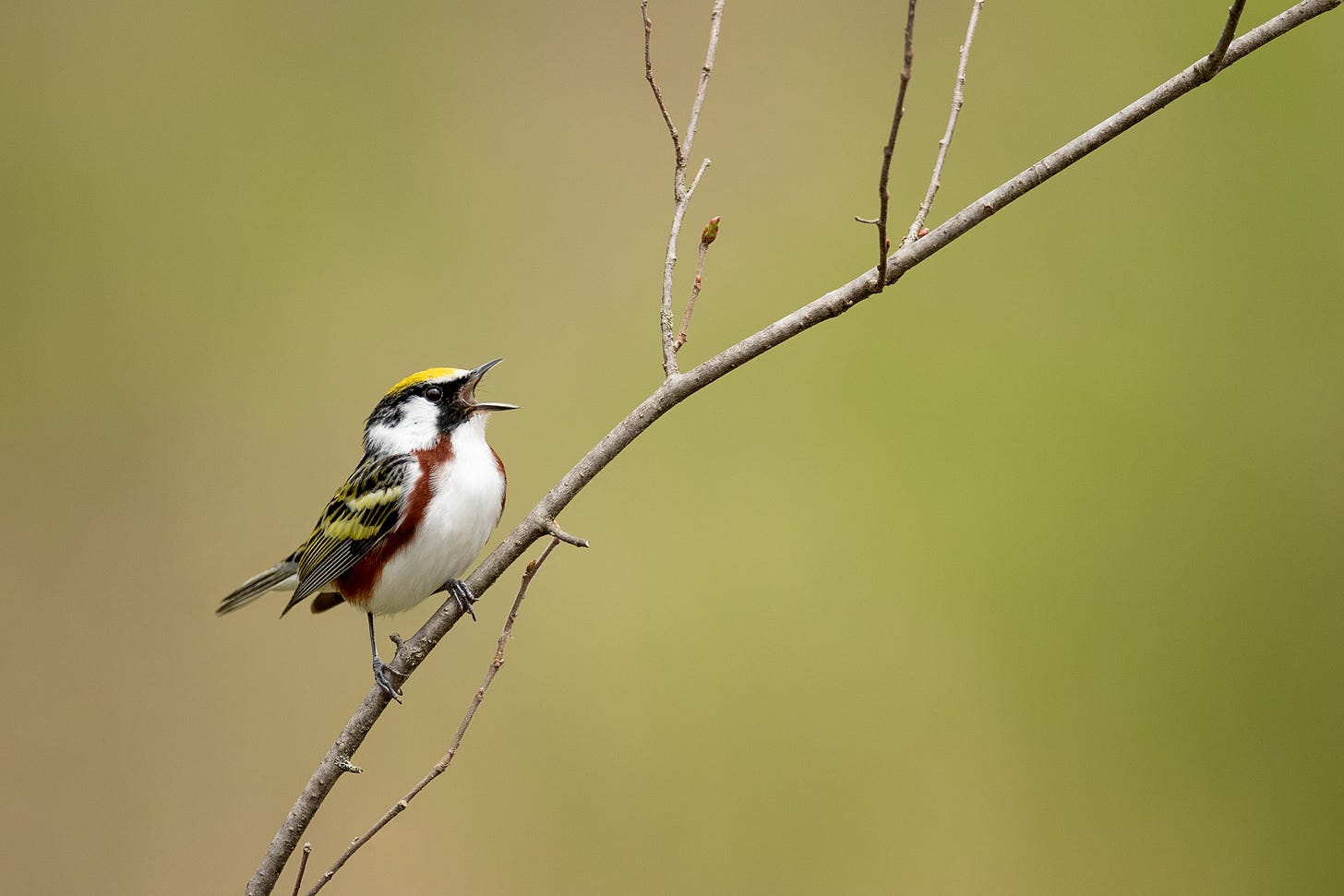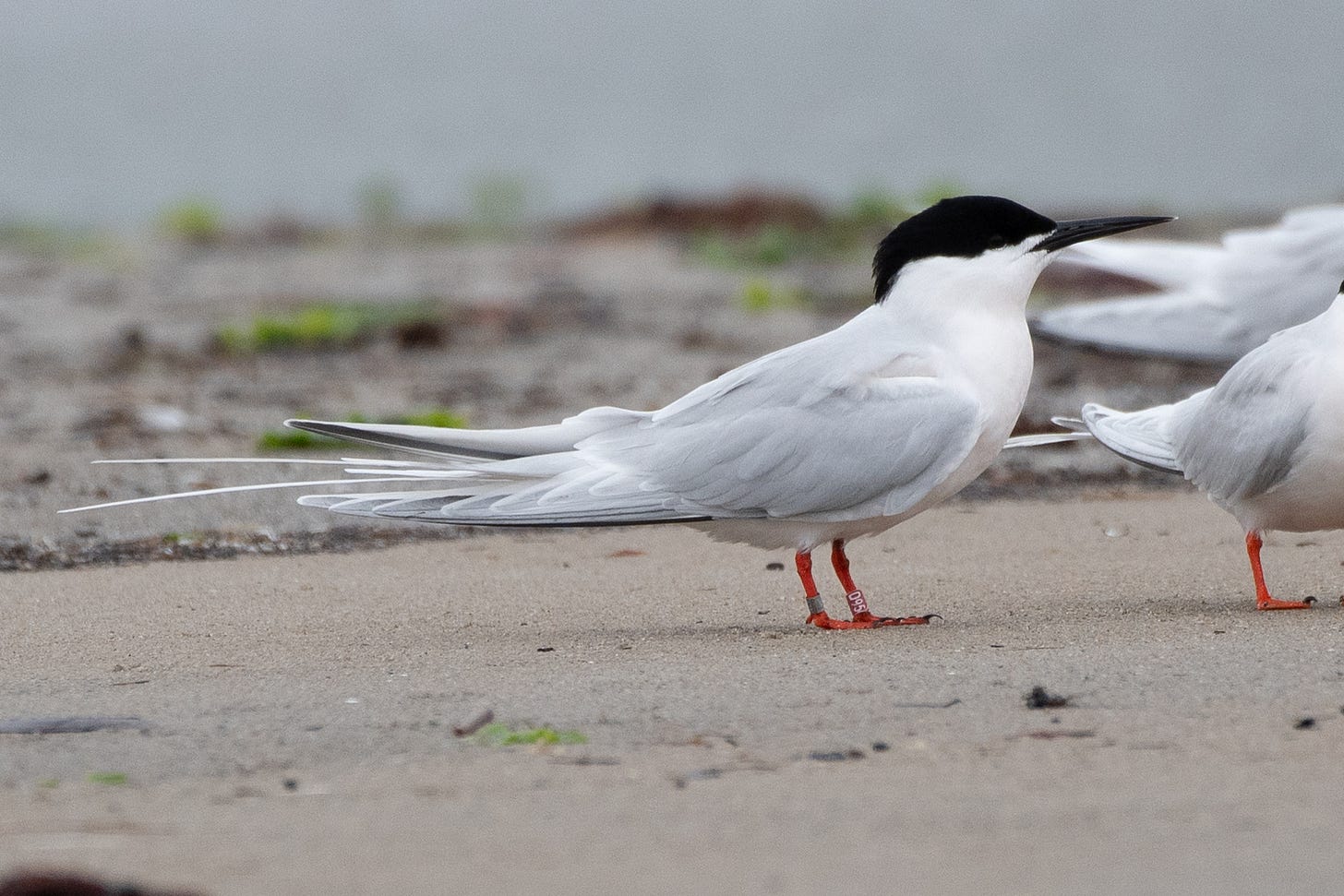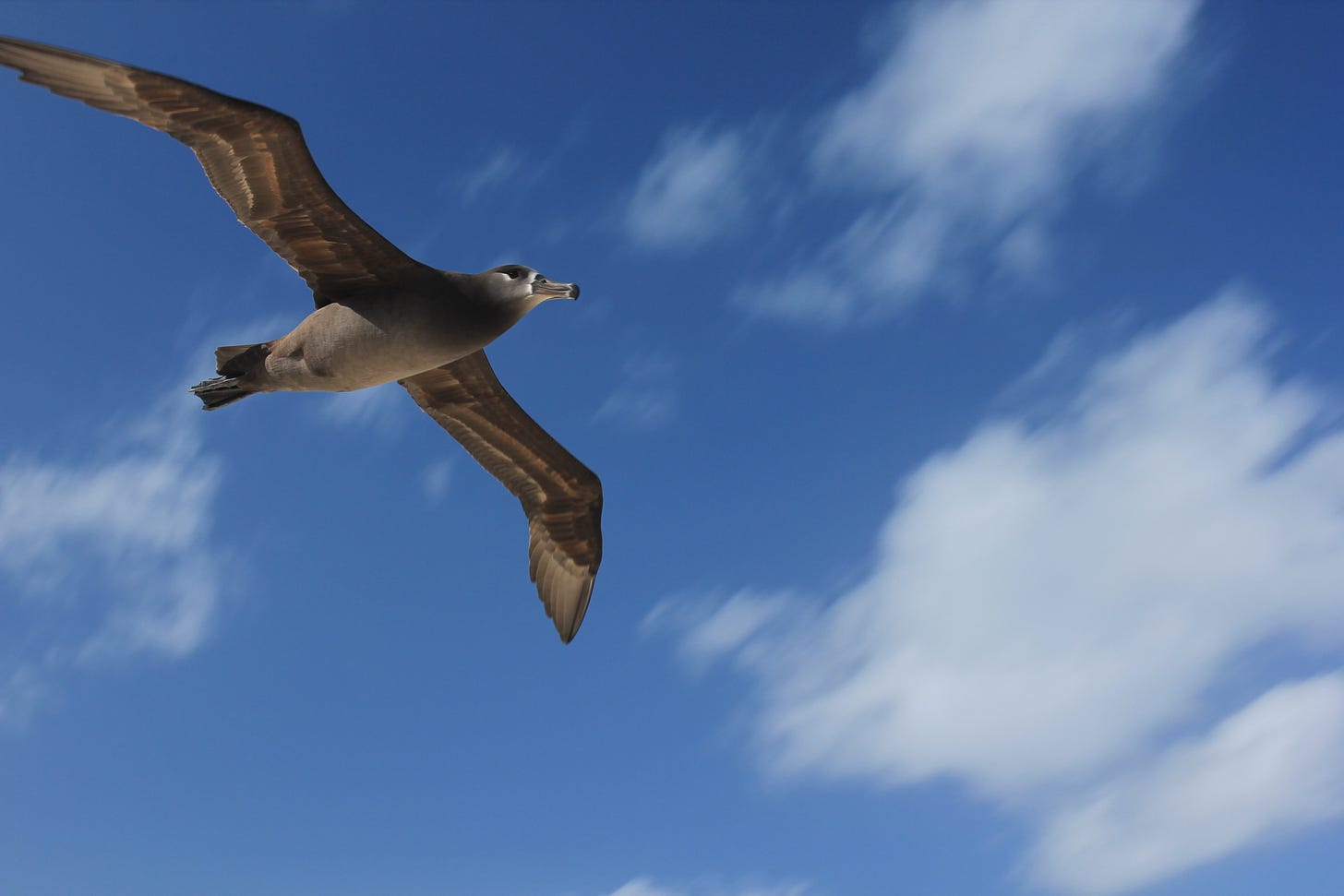Community & Conservation: Find Your Flock
From reporting banded birds to finding others to share the joy of birding with, knowing where to go is the first step

Welcome to the birdy side of the internet! It’s the third Saturday of the month, which means it’s time for our monthly Community & Conservation edition of the Birding University newsletter. This issue features inspiring ways to get involved in bird science, conservation, and community building. From reporting banded birds to protecting albatrosses to tips on finding your own birding community, we hope this issue inspires your own birding journey.
This Week in Birding History: A Top Hotspot Adds Another Species
June 24, 2024 — One year ago this week, biologists at Farallon Islands National Wildlife Refuge recorded a surprise visitor: a Gray-crowned Rosy-Finch (Leucosticte tephrocotis), marking the 441st species observed at Southeast Farallon Island.
Nicknamed “California’s Galápagos” by biologists, the “Devil’s Teeth” by mariners, and the “Islands of the Dead” by the Miwok people, Southeast Farallon Island sits about 30 miles off the coast of San Francisco—and it holds a legendary place in North American birding. With 442 species documented to date (the latest addition is a Song Thrush, observed on November 11, 2024), it currently boasts the highest eBird species count of any hotspot in the United States, Canada, or Mexico.
So what makes the rosy-finch sighting so special? Gray-crowned Rosy-Finches breed in the alpine snowfields of western North America and typically migrate short distances to lower elevations in winter. Discovering one on a relatively warm, offshore island in June is especially unexpected. Even more remarkable, it was found amid one of the most intensively monitored bird survey efforts in North America.
Since the late 1960s, biologists from Point Blue Conservation Science and the U.S. Fish and Wildlife Service have conducted year-round bird surveys on the Farallones. Since 1969, public access has been restricted to protect the islands’ fragile ecosystems and dense seabird colonies, which support an estimated 300,000 to 500,000 seabirds across more than a dozen species.

Birding Tip: How (and Why) to Report Banded Birds
Bird banding—affectionately known as ringing in some parts of the world—is more than just placing a colorful accessory on a bird’s leg. Scientists and trained volunteers attach uniquely coded bands to track individual birds’ movements, behavior, and survival through resighting efforts, helping to answer key questions about migration, habitat use, and lifespan. But reporting banded birds isn’t just for scientists. Birders and nature lovers alike can contribute valuable data simply by spotting and reporting bands in the field. It’s fun, (relatively) easy, and makes a real difference. Here’s why it matters, how to do it, and how your observations can help protect the birds we love.
Why Reporting Banded Birds Matters
Whether it’s a duck harvested by a hunter, a dead seabird washed ashore, or a raptor or shorebird captured in a photograph, a reported band offers biologists valuable insights into migration routes, population trends, and survival rates. Each tiny band tells a story—where a bird was banded, and in some cases, where it was born, how far it has traveled, and how long it has lived. Since 1904, over 77 million birds have been banded in North America, with around 5 million recoveries reported. Each of these sightings helps fuel research that shapes wildlife regulations, guides habitat protection, and even enhances aircraft safety.

How to Report a Banded Bird
Reporting is meaningful, rewarding, and surprisingly simple—even partial information can be valuable. Every report contributes to the U.S. Geological Survey’s Bird Banding Laboratory, which manages all banding data in partnership with the Canadian Wildlife Service through the North American Bird Banding Program.
1. Record the Details
Species & status: Note the bird’s species and whether it was alive or deceased when observed.
Date, time & location: Record the exact date, time, and precise location of the sighting.
Band type: Determine if the bird has a standard silver band (usually with an 8- or 9-digit number), a color band, or both.
Band placement: Document which leg(s) the bands are on. Write down the bands seen from top to bottom on the bird’s left leg first, then top to bottom on the right leg.
Band code: Record the full band number, if possible, or any visible color/letter/number combination.
Other markers: Note any additional markers such as wing tags, neck collars, or leg flags.
Photographs: Take clear photos whenever possible—band numbers can be challenging to read in the field, and colors may fade over time. Photos help researchers confirm details even when field observations are incomplete.
2. Submit Your Report
Online reporting: Visit www.reportband.gov to enter your band sighting information.
If the band is illegible: For worn or damaged bands—especially on deceased birds—you can email details and photos to bandreports@usgs.gov. In some cases, advanced methods like etching may help recover the number (only if you’ve retained the band).
What you’ll receive: Most reports result in a Certificate of Appreciation that includes details such as the bird’s age, sex, banding location, and migration history. Bonus: Some waterfowl bands are part of reward programs.

Real Impacts in the Wild: How Your Band Reports Drive Conservation
Reporting banded birds isn’t just a fun activity—it provides crucial data that directly supports wildlife management and conservation efforts across multiple bird groups. Here are just a few examples of how banding has an impact.
Waterfowl management: Band data from ducks and geese banded in Alaska and Canada help shape North American hunting regulations through Adaptive Harvest Management, meaning more birds for everyone to enjoy.
Shorebird conservation: Bands on species like Red Knots and Piping Plovers have revealed vital wintering grounds and stopover sites, leading to targeted habitat protections. Fun fact: For some species, the color of the band can indicate the country where the bird was banded. A single glance can reveal a piece of the bird’s international story.
Seabird health: Reports of banded seabirds enable NOAA and its partners to assess threats such as plastic ingestion, bycatch, and toxins, which are essential for safeguarding marine ecosystems.
Your Role: Community Scientist
Whether you’re birding along the shore, exploring a wildlife refuge, or notice a band after observing a dead bird, your observation matters. Even if you only catch a few digits or colors, it’s worth reporting. Every single data point helps build population models, inform recovery strategies, and guide conservation efforts.
So next time you spot that glint of metal or flash of color on a bird’s leg, take a moment. Record it. Report it. And take pride in knowing you’re making a real difference—helping shape the future of bird conservation, one band at a time.
Editor's note: Birding University recognizes that the topic of harvesting birds through hunting can be sensitive for some audiences. However, it’s essential to understand that bird banding plays a vital role in both hunting and the broader conservation of bird populations. Reporting banded birds—whether observed in the wild or legally harvested—provides essential data that supports science-based wildlife management and sustainable conservation efforts.
Bird’s Eye View: World Albatross Day
June 19 marked the sixth annual World Albatross Day, a global initiative launched by the Agreement on the Conservation of Albatrosses and Petrels (ACAP) to spotlight the mounting threats facing these magnificent seabirds. Celebrated on the anniversary of ACAP’s founding in 2001, this year’s theme—“Effects of Disease”—draws urgent attention to the escalating toll of bird flu (HPAI) and other pathogens on albatross and petrel populations already strained by industrial fisheries, climate change, and plastic pollution. With 15 of the 22 albatross species currently listed as globally threatened by the IUCN, including two that are Critically Endangered, the stakes have never been higher. Recent outbreaks of avian influenza have led to mass mortalities at key breeding colonies, threatening decades of conservation progress.
Albatrosses are not only graceful navigators of the high seas, capable of traveling tens of thousands of kilometers on a single foraging trip—they’re also critical indicators of ocean health. Their population declines are often early warnings of larger systemic issues, such as fish stock collapse or ecosystem degradation. ACAP, along with conservation partners such as BirdLife International and the Albatross Task Force, has helped pioneer bycatch mitigation strategies, including bird-scaring lines and night settings, which have already reduced seabird deaths by incredible metrics in some fisheries. However, protecting albatrosses now also requires disease monitoring, enhanced biosecurity, and increased public awareness.

Everyone can take part in albatross conservation. Consumers can support seafood brands that use seabird-safe fishing practices. Travelers should follow guidelines to prevent the spread of avian influenza, also known as bird flu. Learn more and get involved at www.acap.aq.
Editor’s note: Birding University recognizes that albatross taxonomy is dynamic and subject to ongoing revision, with different authorities applying varying species concepts. While this article references a commonly cited figure of 22 albatross species, it is important to note that the recently released AviList recognizes 20 species. Taxonomic differences like these reflect the evolving nature of avian science and highlight the importance of continued research and international collaboration in seabird conservation.
Finding Your Flock: How to Build Community Through Birding
Birding can be a beautiful solo endeavor—quiet mornings, a slow walk, binoculars in hand. But it doesn’t have to be a solitary one. Finding a community of fellow birders can deepen your skills, expand your joy, and open the door to lifelong friendships. Birding is about birds, yes—but it’s also about belonging. And just like birds gather in flocks, we can too.
Start with a Local Walk
The good news? Birding communities are everywhere and more welcoming than ever. Start with a local bird walk—offered by nature centers, wildlife refuges, or Audubon chapters. These events are often free, beginner-friendly, and led by local experts who are passionate about helping others discover birds. Not only will you sharpen your skills, but you’ll also meet people who are just as thrilled by a Brown Creeper as you are. Can’t find one nearby? Ask your town’s conservation commission or environmental group—or better yet, organize a walk of your own. You may be surprised who shows up.
Try a Festival—There’s One for Everyone
Festivals are a fantastic way to connect with the birding community. From nationally renowned gatherings like the Biggest Week in American Birding in Ohio, the Space Coast Birding & Wildlife Festival in Florida, and the Rio Grande Valley Birding Festival in Texas to more specialized celebrations of cranes, raptors, or shorebirds, birding festivals offer something for everyone. These events typically feature guided field trips, hands-on workshops, engaging keynote speakers, and ample opportunities for relaxed social time to connect with fellow birders of all experience levels.
Importantly, many festivals now include specific outings for different identities and abilities, including bilingual walks and accessible birding opportunities for people with disabilities. You don’t need to be an expert to attend—just curious and open. These inclusive gatherings are helping reshape birding into a space where everyone feels welcome. Whether you're chasing lifers or simply soaking up the shared enthusiasm, birding festivals offer an energizing space to learn, connect, and celebrate.
Connect Online, Anytime
For those who thrive online, social media is a vibrant hub for birding. Facebook groups like What’s This Bird? offer safe, welcoming spaces to ask for help with bird identification. Other groups focus on local sightings, rare bird alerts, or bird photography. Interested in a particular group of birds? From seabirds and shorebirds to raptors and even jaegers or juncos, there’s likely a Facebook group dedicated to your niche interest. And if there isn’t, create one! Chances are, others will be excited to join.
In today’s age of real-time birding alerts, messaging platforms like WhatsApp, GroupMe, and Discord are popular for geographic-specific rare bird notifications. Local birders can help you find out which app is most commonly used in your area. While a bit more old-school, listservs remain valuable for email-based community discussion and announcements. And don’t underestimate the power of a simple scroll through Instagram—you might discover a birder whose enthusiasm and style resonate with your own.
Use Apps and Join Community Science Projects
Apps like eBird are powerful tools not only for tracking birds but also for connecting with birders in your area. Explore local hotspots, check out who’s submitting sightings, and don’t be shy—reach out to swap tips or meet up for a walk. Suppose you’re interested in making your birding count for science. In that case, community science programs like Climate Watch, the Christmas Bird Count, Global Big Day, and Project FeederWatch are great ways to engage, contribute meaningful data, and bond with others in the process.
Birds Bring Us Together
Whether you’re birding in a crowd or on your own, finding others who share your passion makes the experience richer. Every birder you meet—whether on a walk, in a Discord chat, or at a hawkwatch—brings new perspectives and stories. Maybe even a tip on that life bird you’ve been chasing. Your birding community might span cities, identities, and time zones—but you’ll know when you’ve found your flock. Because, as many birders learn, birding connects us not just to birds, but to each other.
Weekly Poll
If you have, tell us more in the comments! What species was it? Did you report it?
Birding University wants to hear your story.
Thanks for Reading
As always, we’re so grateful you spent time with us this week. We’re honored to be part of your journey as a birdwatcher, a community member, and a conservationist. From reporting banded birds, to celebrating the world’s largest seabirds on World Albatross Day, to sharing a walk with a new birder in your hometown, your actions ripple far beyond your field guide. Stay curious, stay kind—and keep looking up.
* Please visit Phil Stollsteimer Photography for more amazing bird photography.






Birds need open spaces where they can feed or they'll die. Protect our open spaces.